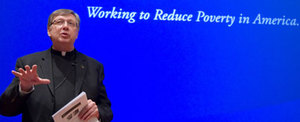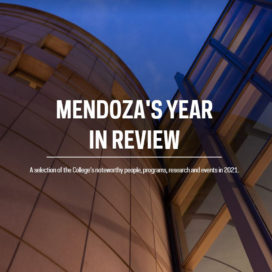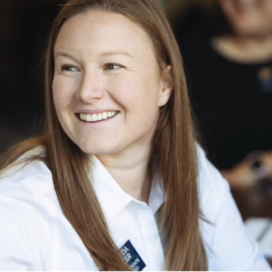Trampolines and Ladders
Published: February 17, 2012 / Author: Ed Cohen

What will poverty be like 10 years from now?
The same as it is now, if anti-poverty groups continue to act only as “safety nets” instead of “trampolines” or “ladders” to help poor people lift themselves up.
That was the message of Father Larry Snyder, president of Catholic Charities USA, in a Ten Years Hence lecture delivered February 17, 2012, at the University of Notre Dame’s Mendoza College of Business. The Ten Years Hence series explores issues, ideas and trends likely to affect business and society over the next decade.
Catholic Charities USA is the largest private network of social service organizations in the United States, with more than 1,700 local agencies and institutions nationwide. They collectively serve more than 9.25 million people a year, regardless of religious, social or economic background.
Snyder, the group’s president since 2005, said charitable agencies too often pride themselves on how much service they provide to poor people – the number of beds made available to those who are homeless, for instance. The agencies see themselves as a social safety net, saving people in times of crisis, he said.
“The problem with a net is that it also catches people,” he said, “Once they get into it, they do not have the resources or the help they need to get out.”
Snyder said anti-poverty efforts should consider a change in paradigm to the trampoline or ladder in order to emphasize “a motion out of poverty – that should be our goal.”
The Catholic Charities president mentioned several examples of innovative approaches to ending poverty, including Twin Cities Rise. Created by a former executive vice president of General Mills, the program trains unemployed and underemployed people in the Minneapolis-St. Paul area for skilled jobs paying at least $20,000 a year.
Snyder said the program has increased participants’ incomes by an average of 355 percent. For every $1 in public funds invested, $7.24 has been returned to Minnesota taxpayers in the form of increased state tax receipts and reduced state subsidies.
Snyder emphasized the need to customize anti-poverty efforts to individual communities and suggested interested parties consult the website opportunityindex.org. It allows people to search by ZIP code for data on their own county’s unemployment rate, median household income, percentage of students who graduate from high school on time, percentage living below the poverty line, and more.
The Ten Years Hence series is sponsored by the O’Brien-Smith Leadership Program, made possible by a generous endowment from William H. O’Brien (ND ’40) and his wife, Dee. The O’Brien-Smith Program endowment provides an opportunity for students and faculty to interact with distinguished leaders from business, government and nonprofit sectors.
/news_and_events/news_articles/article/10792/trampolines-and-ladders




